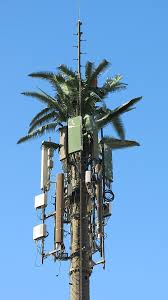Cell towers, also known as cell sites, are those constructions that facilitate cellular transmissions through the mounting of antennas, transmitters, and receivers on towers. These towers amplify and aid in the transmission of radio frequency signals between devices.
These signals are emitted by cell phones and other devices that utilize data packets. So, for your postpaid connection or data services, these towers assist in ensuring you get your money’s worth.
The towers that emit the signals themselves can be of different types based on the requirements and the geographical area they need to cover. The most common ones are Lattice, Monopole, Guyed, and Stealth towers. However, all these towers have a base station which is a locked telecommunications cabinet with signal amplifiers, multiplexers, sound controllers, etc. RF Information is relayed through wires connecting the towers and the base station.
Cell towers can be between 50 and 200 feet tall depending on several requirements, including the distance the signal needs to be boosted for and the closest overlap area with another tower. They may just be standalone structures, or attached to billboards and other lattices. For aesthetic purposes, they might be built in church towers or be camouflaged.
Purpose
Reception and signal strength are extremely important for the functioning of cell phones. This would not be possible without cell towers. Their purpose, therefore, is quite simple, to create an overlapping network so that there is no interruption in transceiving the signals. The capacity Determination and the geographical positioning of the towers is an important factor of consideration. This is so because the overlap between towers must be able to accommodate not just the traffic from old connections but from new connections too.
How it Works?
The signal boosting strength of any tower depends on a lot of factors, like the potential interference it gets due to the geography of the area, the absorption of RF waves by the nearby structures, the directional characteristics of the antenna, etc. Having considered all these features, engineers typically create towers in hexagonal form to create the required overlap and to facilitate the possibility of onboarding new connections.
Since a tower acts as a reception and transmission centre everytime a cellular devices emits Radio frequency waves, the antenna closest to it catches it and transmits the signal to the switching station which acts like a telephone exchange. This signal is then transmitted to either another mobile phone or telephone network

